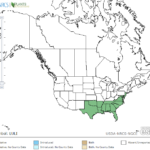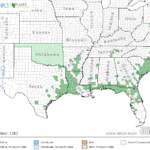Ludwigia linearis
USDA, NRCS. 2018. The PLANTS Database (http://plants.usda.gov, 28 March 2018). National Plant Data Team, Greensboro, NC 27401-4901 USA.
Illustration: USDA-NRCS PLANTS Database / USDA NRCS. Wetland flora: Field office illustrated guide to plant species. USDA Natural Resources Conservation Service.
What is Narrowleaf Primrose?
Physical Characteristics
Leaves:
- Linear to elliptical shaped
- 0.98-2.4 inches long
- 0.06-0.2 inches wide
- Almost immobile
Flowers:
- 4 sepals, 0.01-0.16 inches long
- Petals 0.14-0.2 inches long
- 4 stamen
- Fleshy
- 4 lobes
- Lobes opposite the petals
Fruit:
- Dry
- Shaped like a stretched pyramid
- 0.24-0.31 inches long
Seeds:
- Several indistinct rows
- About 0.02 inches long
Stem:
- Well branched
- Up to 3 feet tall
Where Does it Grow?
Narrowleaf primrose can be found in wet places, especially in pine woods, seepage slopes, ditches, wet savannas, and ponds.
Pros and Cons of Narrowleaf Primrose
Ducks and other waterfowl will consume the seeds of water primrose. Submerged portions of all aquatic plants provide habitats for many micro and macro invertebrates. These invertebrates in turn are used as food by fish and other wildlife species (e.g. amphibians, reptiles, ducks, etc). After aquatic plants die, their decomposition by bacteria and fungi provides food (called “detritus”) for many aquatic invertebrates.


